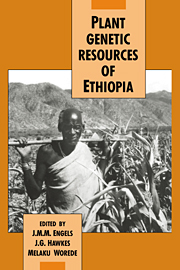Book contents
- Frontmatter
- Contents
- Contributors
- List of acronyms
- Preface
- Part I General introduction
- Part II The Ethiopian centre of diversity
- Part III Germplasm collection and conservation in Ethiopia
- 13 Theory and practice of collecting germplasm in a centre of diversity
- 14 A decade of germplasm exploration and collecting activities by the Plant Genetic Resources Centre/Ethiopia
- 15 Collection of Ethiopian forage germplasm at the International Livestock Centre for Africa
- 16 Germplasm conservation at PGRC/E
- 17 Documentation at PGRC/E
- Part IV Evaluation and utilization of Ethiopian genetic resources
- Index
14 - A decade of germplasm exploration and collecting activities by the Plant Genetic Resources Centre/Ethiopia
Published online by Cambridge University Press: 30 October 2009
- Frontmatter
- Contents
- Contributors
- List of acronyms
- Preface
- Part I General introduction
- Part II The Ethiopian centre of diversity
- Part III Germplasm collection and conservation in Ethiopia
- 13 Theory and practice of collecting germplasm in a centre of diversity
- 14 A decade of germplasm exploration and collecting activities by the Plant Genetic Resources Centre/Ethiopia
- 15 Collection of Ethiopian forage germplasm at the International Livestock Centre for Africa
- 16 Germplasm conservation at PGRC/E
- 17 Documentation at PGRC/E
- Part IV Evaluation and utilization of Ethiopian genetic resources
- Index
Summary
Introduction
The richness of Ethiopia's biological resources is well known. It has been mentioned by several scientists that the country exhibits an extraordinary genetic diversity in cereals such as barley (Hordeum vulgare), wheat (Triticum spp.), sorghum (Sorghum bicolor) and teff (Eragrostis tef), oil crops such as castor bean (Ricinus communis), sesame (Sesamum indicum), and other lesser known but potentially valuable species of plants. Eleven cultivated crop species have been identified as having their centre of diversity in Ethiopia (Zohary, 1970). Vavilov (1951) indicated that some 38 species are connected with Ethiopia as a primary or secondary gene centre.
Owing to the potential and uniqueness of the biological resources of this country, numerous exploration expeditions have been undertaken in the past. The earliest was probably the one made by Schimper in 1840, a year which appears to mark the beginning of botanical collecting in Ethiopia (Gentry, 1971). However, it was after the establishment of the Plant Genetic Resources Centre/Ethiopia (PGRC/E) that systematic collecting was launched on a large scale.
Agents of genetic erosion
The valuable genetic diversity in Ethiopian crop species, as well as in their related wild species, has been built up over the centuries by the natural selective forces of the environment and the farming community.
- Type
- Chapter
- Information
- Plant Genetic Resources of Ethiopia , pp. 202 - 217Publisher: Cambridge University PressPrint publication year: 1991
- 2
- Cited by



